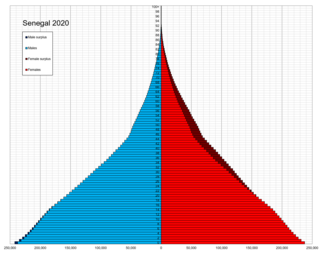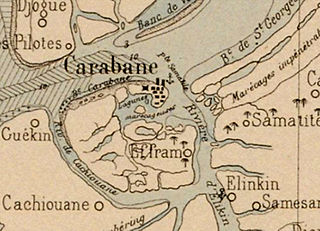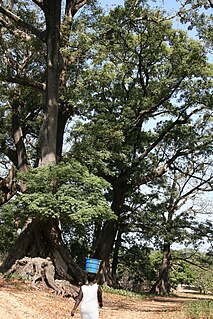
Senegal, officially the Republic of Senegal, is a country in West Africa. Senegal is bordered by Mauritania in the north, Mali to the east, Guinea to the southeast, and Guinea-Bissau to the southwest. Senegal nearly surrounds The Gambia, a country occupying a narrow sliver of land along the banks of the Gambia River, which separates Senegal's southern region of Casamance from the rest of the country. Senegal also shares a maritime border with Cape Verde. Senegal's economic and political capital is Dakar.

This article is about the demographic features of the population of Senegal, including population density, ethnicity, education level, health of the populace, economic status, religious affiliations and other aspects of the population.

Casamance is the area of Senegal south of the Gambia including the Casamance River. It consists of the Lower Casamance and the Upper Casamance. The largest city of Casamance is Ziguinchor.

The Serer-Ndut or Ndut also spelt are an ethnic group in Senegal numbering 38600 They are part of the Serer people who collectively make up the third largest ethnic group in Senegal. The Serer-Ndut live mostly in central Senegal in the district of Mont-Roland, northwest of the city of ancient Thiès.
The Mlomp language, also known as Gulompaay, is spoken in Senegal. It belongs to the Bak branch of the Niger–Congo language family, and is closely related to the Karon language.

The Jola or Diola are an ethnic group found in Senegal, the Gambia, and Guinea-Bissau. Most Jola live in small villages scattered throughout Senegal, especially in the Lower Casamance region. The main dialect of the Jola language, Fogni, is one of the six national languages of Senegal.

Senegal is a multilingual country: Ethnologue lists 36 languages, Wolof being the most widely spoken language.
Jola or Diola is a dialect continuum spoken in Senegal, the Gambia, and Guinea-Bissau. It belongs to the Bak branch of the Niger–Congo language family.

Mlomp is a rural community and village in the Ziguinchor Region of Senegal in the Casamance, situated approximately 40 km (25 mi) south-west of Ziguinchor.
Jola, also called Jola-Fonyi and Kujamataak, is a language spoken by half a million people in the Casamance region of Senegal, and neighboring countries. Jola-Fonyi is one of several closely related Jola languages spoken in the area.

Carabane, also known as Karabane, is an island and a village located in the extreme south-west of Senegal, in the mouth of the Casamance River. This relatively recent geological formation consists of a shoal and alluvium to which soil is added by accumulation in the branches and roots of the mangrove trees which cover most of the island. Along with the rest of Ziguinchor Region, Carabane has a tropical climate, cycling between a dry season and a wet season. The island was once considered an arid location where no useful plants were likely to grow, but it now supports several types of fruit tree, the most common of which are mangos and oranges. Although the nearby Basse Casamance National Park and Kalissaye Avifaunal Reserve have been closed for years because of the Casamance Conflict, Carabane has continued to attract ornithologists interested in its wide variety of birds. Various species of fish are plentiful around the island, but there are very few mammals.

There are various ethnic groups in Senegal, The Wolof according to CIA statistics are the majority ethnic group in Senegal. Many subgroups of those can be further distinguished, based on religion, location and language. According to one 2005 estimate, there are at least twenty distinguishable groups of largely varying size.

Baïla is a village in the rural community of Suelle, Sindian, Bignona, Ziguinchor, Casamance, Senegal.

Diembéring is a village in Senegal in the rural community of the same name. It is located in Cabrousse, Oussouye, Ziguinchor, Casamance, approximately 10 km north of Cap Skirring and 60 km from Ziguinchor.
The Bak languages are a group of typologically Atlantic languages of Senegal and Guinea-Bissau linked in 2010 to the erstwhile Atlantic isolate Bijago. Bak languages are non-tonal.
Kasa, or Jóola-Kaasa is a Jola language of the Casamance region of Senegal and neighboring Gambia.
Ejamat (Ediamat), or Jola-Felupe is a Jola language of the Casamance region of Senegal and neighboring Guinea-Bissau, including around Calequisse (Kaləkis), on the western edge of the Manjak area south of the Cacheu River. A person is called ɸuluɸ or ajamuʂay by speakers of the dialect, and the language is called either ɛlɔp eluɸay or ɛlɔp ɛjamuʂay.

Ziguinchor is the capital of the Ziguinchor Region, and the chief town of the Casamance area of Senegal, lying at the mouth of the Casamance River. It has a population of over 230,000. It is the seventh largest city of Senegal, but largely separated from the north of the country by The Gambia.
The King of Oussouye is a religious, spiritual and traditional leader of the Jola people who follow their traditional religion. The Jolas believe in a god called Ata Emit. The King is an intermediary between God and men. The king is described as a "collaborator of God who receives offerings to pray and intercede with the spirits".
Wolofization or Wolofisation is a cultural and language shift whereby populations or states adopt Wolof language or culture, such as in the Senegambia region. In Senegal, Wolof is a lingua franca The Wolofization phenomenon has taken over all facets of Senegal and encroaching on Gambian soil. This phenomenon has caused other Senegambian ethnic groups great concern and resulted in taking steps to preserve their languages and culture. In this regard, the Serer ethnic group who have had a long history fighting against Islamization and Wolofization have been taking active steps in the past decades by setting up associations and other organisations in order to preserve their languages, culture and "ancient religious past." Haalpulaar speakers, namely the Fula and Toucouleur have also been taking steps to preserve their language.













